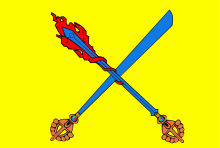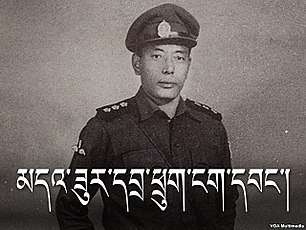Chushi Gangdruk
| Chushi Gangdruk | |
|---|---|
| ཆུ་བཞི་སྒང་དྲུག་ | |
 Badge of the "Tibetan Volunteer Defenders of the Faith". Inscription in Tibetan is gangs ljongs bstan srung dang blangs. | |
| Leader(s) | Andruk Gonpo Tashi |
| Dates of operation | June 16, 1958–1974 |
| Dissolved | 1974[1] |
| Flag |
 |
Chushi Gangdruk (Tibetan: ཆུ་བཞི་སྒང་དྲུག་, Wylie: Chu bzhi sgang drug , literally "Four Rivers, Six Ranges", full name: Tibetan: མདོ་སྟོད་ཆུ་བཞི་སྒང་དྲུག་བོད་ཀྱི་བསྟན་སྲུང་དང་བླངས་དམག་, Wylie: mdo stod chu bzhi sgang drug bod kyi bstan srung dang blangs dmag , "the Kham Four Rivers, Six Ranges Tibetan Defenders of the Faith Volunteer Army"[2]) was an organization of Tibetan guerrilla fighters who attempted to stop the invasion of the People's Republic of China (PRC) in Tibet. The Dokham Chushi Gangdruk organization, a charity set up in New York City and India with chapters in other countries, now supports survivors of the Chushi Gangdruk resistance currently living in India. Chushi Gangdruk also led The 14th Dalai Lama out of Lhasa, where he had lived, soon after the start of the Chinese invasion. During that time, a group of Chushi Gangdruk guerillas was led by Kunga Samten, who is now deceased.[3] Because the United States was prepared to recognize People's Republic of China in the early 1970s, CIA Tibetan Program, which funded the Chushi Gangdruk army, has to be ceased. [4]
Name
Chushi Gangdruk "Four Rivers, Six Ranges" is the name traditionally given to the eastern Tibetan region of Kham where the gorges of the Salween (Tib. Ngul-chu), Mekong (Da-chu), Yangtze (Dri-chu) and Yalong (Dza-chu) rivers, all arising on the Tibetan Plateau, pass between six parallel ranges of mountains that form the watersheds for these rivers. "Chu" (choo) is the Tibetan word for "water", and "shi" (she) is the Tibetan word for 4. "Gang" is range, and "druk" (drewk) means 6.
History
The formation of the Chushi Gangdruk Volunteer Force was announced on June 16, 1958. It was called National Volunteer Defence Army (NVDA). "Chushi Gangdruk" is a Tibetan phrase meaning "land of four rivers and six ranges," and refers to Amdo and Kham. The group included Tibetans from those regions of eastern Tibet, and its main objective was to drive PRC occupational forces out of Tibet. While central and western Tibet (Ü-Tsang) were bound by a 17-point agreement with the People's Republic of China, the PRC initiated land reform in eastern Tibet (including Amdo and Kham) and engaged in harsh reprisals against the Tibetan land-owners there.

Under the direction of General Andrug Gonpo Tashi, Chushi Gangdruk included 37 allied forces and 18 military commanders. They drafted a 27-point military law governing the conduct of the volunteers. Their headquarters were located at Tsona, then later moved to Lhagyari.
Initially militia members purchased their own weapons, mainly World War II-era British .303 in, German 7.92 mm, and Russian 7.62 mm caliber rifles. Chushi Gangdruk contacted the US government for support. However, the State Department required an official request from the Tibetan government in Lhasa, which was not forthcoming. State Department requests were made and ignored in both 1957 and 1958.
Eventually, the US Central Intelligence Agency provided the group with material assistance and aid, including arms and ammunition, as well as training to members of Chushi Gangdruk and other Tibetan guerrilla groups at Camp Hale.
From 1960, Chushi Gangdruk conducted its guerrilla operations from the northern Nepalese region of Mustang.[6] In 1974, guerrilla operations ceased after the CIA, given the realignment of Sino-American relations initiated by President Richard Nixon, terminated its program of assistance to the Tibetan resistance movement and the Dalai Lama, the exiled Tibetan spiritual and temporal leader, taped a message telling the Tibetans to lay down their weapons and surrender peacefully.
See also
- List of organizations of Tibetans in exile
 Ratuk Ngawang was in ‘Four Rivers, Six Ranges’, the Tibetan resistance force against the Communist Chinese
Ratuk Ngawang was in ‘Four Rivers, Six Ranges’, the Tibetan resistance force against the Communist Chinese - Tibetan American
- Tibetan Resistance Since 1950
- Special Frontier Force
References
Citations
- ↑ "Resistance and Revolution". Tibet Oral History Project. Retrieved 2017-06-25.
He went to India after the Nepalese Government disbanded the unit in 1974.
- ↑ Goldstein, Melvyn: A History of Modern Tibet. Vol. 2. The Calm before the Storm, 1951-1955, University of California Press, London, 2007, p. 598
- ↑ "Membership & Support". Chushigangdruk.org. Archived from the original on 2012-07-17. Retrieved 2012-06-10.
- ↑ Stephen Talty (Dec 31, 2010). "The Dalai Lama's Great Escape". The Daily Beast.
- ↑ Thondup, Gyalo; Thurston, Anne F. (2015). The Noodle Maker of Kalimpong: The Untold Story of My Struggle for Tibet. Gurgaon, India: Random House India. p. 169. ISBN 978-818400-387-1.
Most of the resisters in India were followers of Andrug Gompo Tashi, a wealthy, patriotic Kham trader from Litang where the resistance had begun with the introduction of China's so-called reforms. Popular outrage had been further fueled with the death and destruction unleashed when the Chinese attacked and bombed the local Litang monastery.
- ↑ Cowan, Sam (17 January 2016). "The curious case of the Mustang incident". The Record. Retrieved 2017-02-10.
Sources
- Tsering Shakya, The Dragon in the Land of Snows - A History of Modern Tibet Since 1947, Columbia University Press, 1999, ISBN 0-231-11814-7.